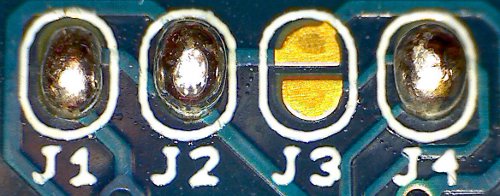Footprint For Solderable Jumper?
Printed From: PCB Libraries Forum
Category: General
Forum Name: General Discussion
Forum Description: general topics not related to other forums
URL: https://www.PCBLibraries.com/forum/forum_posts.asp?TID=2089
Printed Date: 26 Dec 2025 at 12:16am
Topic: Footprint For Solderable Jumper?
Posted By: LaserAlex
Subject: Footprint For Solderable Jumper?
Date Posted: 13 Feb 2017 at 2:55pm
Does anyone have experience generating good (or bad!) footprints for solderable jumpers? I'm looking to configure a circuit board with something like this: Or this:  I want something that is easy and quick to connect, but also easy to desolder and clean up for reconfiguration. If it makes any difference, the intent is to use lead-free solder. Has anyone done this, with good or bad results? Can anyone provide pointers? Better yet, dimensions / configuration or even an Altium footprint for a "known-good" solder jumper? Thanks!
|
Replies:
Posted By: Tom H
Date Posted: 13 Feb 2017 at 3:42pm
|
Your picture is an OK example. There are just a couple rules -
Here are some alternate solder jumpers that work well -  ------------- Stay connected - follow us! https://twitter.com/PCBLibraries" rel="nofollow - X - http://www.linkedin.com/company/pcb-libraries-inc-/" rel="nofollow - LinkedIn |
Posted By: LaserAlex
Date Posted: 13 Feb 2017 at 8:16pm
|
Thank you for the quick response, Tom! The options with the interdigitated contacts look like they would be very easy to short reliably, but I'm worried about the difficult of cleaning them up if the configuration needed to change. I'm sure solder wick and flux could clean them out, but I really want something easy to work with. Have you personally soldered and desoldered all of these? If you were tasked with reconfiguring a thousand of these jumpers, which would you prefer had been used on the board? Thanks! -Alex
|
Posted By: Tom H
Date Posted: 13 Feb 2017 at 8:51pm
|
I'm an IPC CIT trainer for soldering and J-STD-001 solder joint acceptability and these patterns clean up really nice. Place a solder wick on the solder and apply the iron and the solder wick sucks up the solder and with a wire mesh touchup it should be clean to go. Old fashion pad with hole and wire is still a popular Jumper solution. Even a wire loop across 2 SMD pads with easy access to cut. No need to use a solder iron. ------------- Stay connected - follow us! https://twitter.com/PCBLibraries" rel="nofollow - X - http://www.linkedin.com/company/pcb-libraries-inc-/" rel="nofollow - LinkedIn |
Posted By: LaserAlex
Date Posted: 13 Feb 2017 at 8:54pm
| Thanks, Tom. Great info! |
Posted By: MSM_KOPF
Date Posted: 22 Feb 2019 at 5:34am
|
How should such a footprint be named ? In my current footprint there are 2 pads each 0.5 x 1.0mm with a gap of 0.2mm between the 2 long sides. (02.mm Gap due to clearance requirements) There are versions of this footprint. 1. without any solder paste for an open solderable jumper 2. with solder paste over both pads and the gap between the pads for a close jumper after reflow A resistor would be something like "RESC1608X70" Is there any naming convention or recommendations for both footprints? |
Posted By: Tom H
Date Posted: 22 Feb 2019 at 8:46am
|
If it's a Jumper I would use: JUMP0510WP = Jumper 0.5 X 1.0 With Paste JUMP0510WOP = Jumper 0.5 X 1.0 With Out Paste You get the idea. ------------- Stay connected - follow us! https://twitter.com/PCBLibraries" rel="nofollow - X - http://www.linkedin.com/company/pcb-libraries-inc-/" rel="nofollow - LinkedIn |
Posted By: DrewRu
Date Posted: 04 Oct 2019 at 7:22am
|
Hi, It is still common to represent this as an
optional 0 Ohm resistor and many designs still use a 0-Ohm SMD link; you
just have to remember to use the right footprint for the artwork if you
want to use a solder bridge.
|